What varieties of carrots are best for growing in the Urals
Carrots are a popular vegetable in any kitchen. It is needed in first and second courses, in salads, in the preparation of winter preparations, lecho and sauces. Not a single personal plot is complete without planting this culture. Almost all regions of the country, including the Urals, are suitable for growing carrots. However, to obtain a rich harvest, it is necessary to choose the right variety suitable for the harsh climate and create favorable conditions for its cultivation.
The content of the article
Features of the climate in the Urals
The weather conditions in the Urals are quite varied. The length of the Ural mountain range is more than 2,300 km, it stretches from north to south through the central part of Russia. therefore the climate in different parts of the Urals is significantly different.
In the central and southern regions, carrots are grown according to the usual scheme, which differs from the planting rules in the northern part.
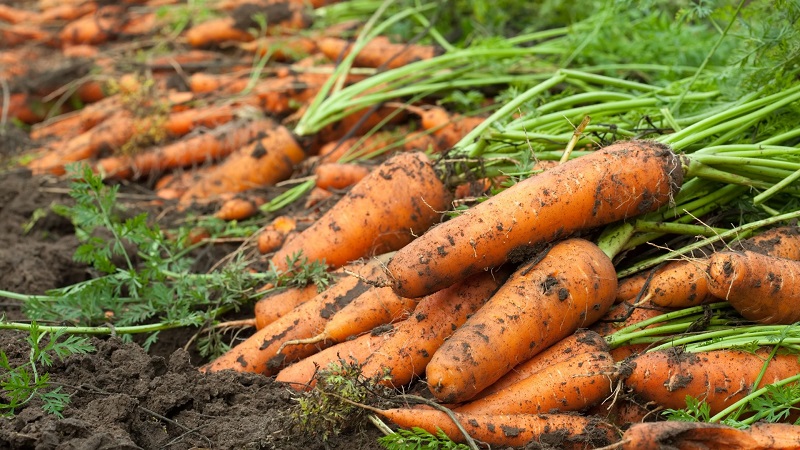
Many farmers are interested in the possibility of growing carrots in the northern Urals. The northern Urals are characterized by a harsh climate with severe frosts., cold winds and few sunny days.
For best results, you must first select a variety that is frost-resistant and adapts to sudden temperature changes. And most importantly, the variety must have time to give a crop before the onset of frost, that is, be early maturing.
Good crop care will help the plant grow and mature under adverse weather conditions in this region.
Carrot planting technology in the Urals
Regardless of the region, the soil begins to be prepared in the fall.... If the land on the site is heavy, in the fall it is dug up with sand and neutral peat at the rate of 2.5-3 kg of peat per sq. m. To improve the nutritional properties, wood ash is introduced into the soil during digging. If the soil is acidic, it is dug up with the addition of lime, dolomite flour, while making 0.5 kg per sq. m.
When digging, remove all plant residueswhich pests I use as winter shelters. For disinfection, it is useful to pour the soil with a pink solution of potassium permanganate. To nourish the soil over the winter, mineral fertilizers are applied to it. Prepare a solution consisting of 30 g of superphosphate, 20 g of urea, 20 potassium sulfate in 10 l of water, and spill the soil. The plot is leveled with a rake and left until spring.
In the spring, before sowing carrots, the soil is loosened, eliminating the soil crust formed during the winter. When loosening, compost or humus is introduced into the soil.
Rules for growing carrots in the Urals
Planting a culture is carried out when the soil warms up to a temperature of 8-10 ° C... In the central and southern parts of the Urals, planting begins at the end of April. In the northern part, planting dates are delayed until mid-May. The air temperature during the day should be within + 10 ... + 15 ° С, at night - not lower than + 5 ... + 7 ° С.
At this time, the probability of night frosts is minimal.
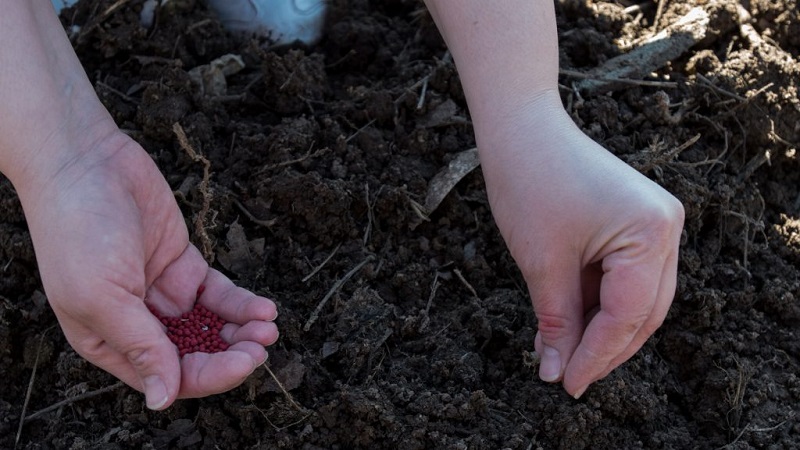
In autumn, in the north of the Urals, they are rarely planted, since in winter the air temperature in these areas drops to -35 ° C. Not every variety is able to withstand such frosts.
When choosing a variety of carrots, take into account for which regions of the Urals is it recommended to plant seeds.
Important! In the northern part of the Urals, autumn comes quickly, so a variety is chosen that will have time to ripen during the short summer.
A sunny site is chosen for planting crops, which is especially important in the northern Urals, where sunny days are rare. The site should not be in a low place, there will accumulate water after rains.They choose a place protected from strong winds typical of the macroregion.
Carrot seeds are pre-prepared... First, strong seeds are selected, discarding deformed seeds. Then they are immersed in a container of water for two hours. During this time, empty seeds will float up, they are thrown away. The remaining seeds are disinfected in the "Fitosporin" solution: 2 g of dry preparation per 1 liter of water. Then sprout by wrapping in a damp cloth. You can germinate in the Epin solution: 4 drops per 1 liter of water. After 5-6 days, the seeds are planted in the ground.
In the prepared area, grooves are made with a depth of 2-2.5 cm... Germinated seeds are placed in them at a distance of 2-3 cm. 20 cm are left between the rows. The seeds are carefully sprinkled with earth, the garden is watered with a watering can so that the stream of water does not erode the soil. Then the surface of the soil is slightly tamped to increase the contact of the seeds with the moist soil.
Seedlings begin to appear as soon as the soil warms up to 8-10 ° C. In the northern Urals, this occurs in early June.
The first time the beds are watered with a small amount of water every three days depending on weather conditions. As soon as the seedlings grow up to 15-20 cm, watering is reduced to once a week, but they are made more abundant.
When the seedlings have two pairs of leaves, thinning is carried outremoving weak instances. Further thinning is performed as the seedlings grow. A distance of 6-7 cm is left between adult plants.
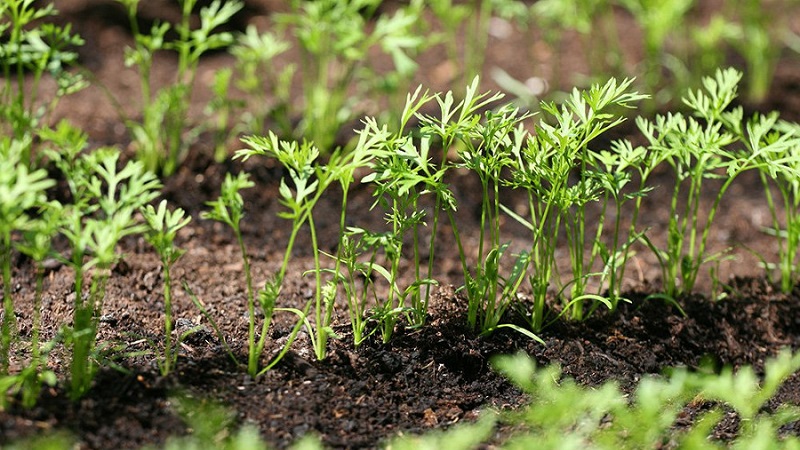
Weeds are removed simultaneously with thinning and loosen the soil to improve oxygen access to the roots.
During the growth of the culture, three additional fertilizing... The first is carried out 20 days after germination. To do this, use solutions:
- 10 g nitrophoska and 10 l of water;
- 15 g potassium sulfate, 15 g superphosphate, 10 g urea per bucket of water.
Attention! Top dressing is performed only on pre-moistened soil.
Watering with fertilizers at the root is recommended in the morning.
The second feeding is performed 14-20 days after the first... In this case, the main components are introduced: potassium, nitrogen, phosphorus. A solution is prepared, consisting of 10 g of potassium sulfate, 10 g of ammophoska and 10 liters of water.
At the third feeding, nitrogen is introduced by watering the culture with a solution of wood ash: 200 g of ash is poured with warm water, insisted for a day and watered at the root. Top dressing is carried out three weeks after the second.
Reference! Nitrogen fertilizers are not used during the third feeding.
The harvest time depends on the area and variety... In the northern parts of the Urals, the crop is planted later, so the harvest time is also shifted by as much as the variety was planted later.
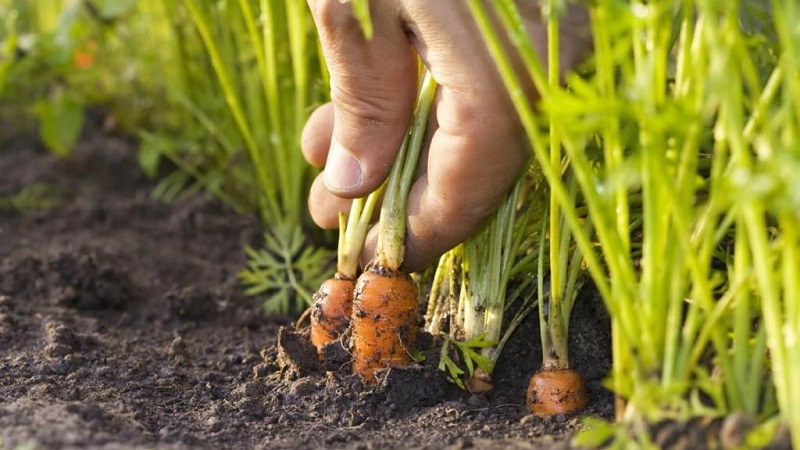
For the Urals, varieties that ripen before the onset of cold weather are best suited... For this purpose, biologists have developed varieties that are early maturity and resistance to temperature drops.
Read also:
Early varieties for the Urals
For growing in the harsh climatic conditions of the Urals, carrot varieties that mature during the short summer:
 Amsterdam - ripening period 90 days. Root crops are cylindrical with a rounded tip. The length of vegetables is 15-17 cm, weight is 120-150 g. The pulp is sweet, crispy. The variety does not lose its external and taste characteristics with excess moisture. Productivity - 6-7 kg per sq. m.
Amsterdam - ripening period 90 days. Root crops are cylindrical with a rounded tip. The length of vegetables is 15-17 cm, weight is 120-150 g. The pulp is sweet, crispy. The variety does not lose its external and taste characteristics with excess moisture. Productivity - 6-7 kg per sq. m.- Hybrid Victoria F1 (pictured) - ripening period 80 days. Root crops are red-orange in color, cylindrical in shape, rounded at the end, the length of vegetables is 18-20 cm. The variety is suitable for growing on all types of soil.
- Alenka - ripens in 70-80 days. The fruits are cone-shaped with a blunt tip, smooth, 12-16 cm long. The weight of vegetables reaches 300-400 g. The pulp is sweet, with a pleasant aroma. Excellent keeping quality.
- Boltex - ripening period - 80-88 days. Root crops are short -11-15 cm, cone-shaped. The pulp is juicy, sweet. The yield of the variety is 8-10 kg per sq. m. Can be used for winter sowing.
Mid-season varieties for the Ural area
These varieties have medium ripening times.:
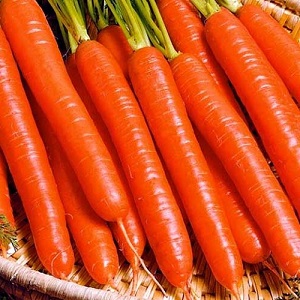 Vitamin 6 - ripening period 120-130 days. Fruits in the form of a cylinder with a rounded tip, red-orange color, length 14-15 cm, weight 100-160 g. The surface of the vegetable is smooth, the eyes are small, the core is thin. The variety is suitable for winter sowing.
Vitamin 6 - ripening period 120-130 days. Fruits in the form of a cylinder with a rounded tip, red-orange color, length 14-15 cm, weight 100-160 g. The surface of the vegetable is smooth, the eyes are small, the core is thin. The variety is suitable for winter sowing.- Altai shortened - a resistant variety, suitable for the climate of the Urals. Ripening occurs 120 days after sowing the seeds. Cylindrical roots, weight 140-150 g. Sweet taste, suitable for any dish. The variety tolerates a drop in temperature well. Cultivation on an industrial scale is possible.
- Callisto F1 - ripening period 90-110 days. Root crops are cylindrical, 20–22 cm long, weighing 80–130 g. Small eyes on the surface. The pulp is reddish. The yield of the variety is 2.5–4 kg per sq. m. Suitable for long-term storage.
- Nantes 4 - ripens in 95-110 days. Root crops 16-17 cm long, weight 160-170 g. Productivity - 6-6.5 kg per sq. m. The pulp is sweet, juicy. Differs in good keeping quality.
Late varieties
Late varieties and hybrids of carrots are intended for long-term storage:
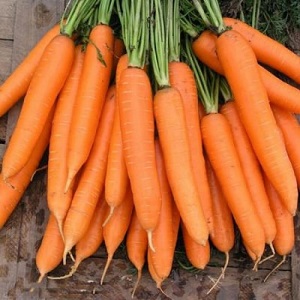 Totem F1 - ripening period 130-140 days. Root crop in the form of a cone, with a pointed tip, length 20-25 cm, weight 115-140 g. The skin and flesh are reddish. The pulp is juicy and crispy. Productivity - 5-6.5 kg per sq. m.
Totem F1 - ripening period 130-140 days. Root crop in the form of a cone, with a pointed tip, length 20-25 cm, weight 115-140 g. The skin and flesh are reddish. The pulp is juicy and crispy. Productivity - 5-6.5 kg per sq. m.- Shantane 2461 - ripens 130-145 days. The fruits are even, tapering to the tip. Dina vegetables 13-15 cm, weight 190-240 g. The core is yellow, thick, dense. Productivity 4-8 kg per sq. m. Good keeping quality.
- Tinga F1 - ripening period 135 days. The root crop is long, the shape of a pointed cone, the skin is red-orange, the flesh is dense. The weight of vegetables is 105-125 g. The yield is 4.5-5.5 kg per square meter. m. The taste is excellent.
Other varieties of carrots:
Storage features
In the conditions of a short and cool summer in the northern Urals, late varieties do not always have time to ripen, therefore crops with an early ripening period are more suitable for growing in the Urals... However, keep in mind that early carrots have a short shelf life. Therefore, for winter storage, mid-season varieties are sown, characterized by increased keeping quality.
So that roots do not spoil during storage, comply with basic requirements:
- For planting, zoned varieties are chosen, that is, those recommended for specific climatic conditions.
- After harvesting, the vegetables are sorted out, the tops are cut off. Damaged fruits are not suitable for long-term storage, they will begin to rot and spoil neighboring root crops.
- Root crops are dried before being placed in storage.
- It is recommended to pre-wash the storage room with disinfecting solutions, antiseptics.
- Carrots are best stored in containers filled with sand.
- The room must be well ventilated.
- The temperature is maintained at the level of 1-4 ° C, the humidity is 85-90%.
The stored vegetables are systematically checked... Root crops with areas of rot are immediately removed so that neighboring vegetables do not deteriorate.
If all conditions are met, the carrots will be stored until the new season.
Conclusion
Planting carrots in the central and southern regions of the Urals is almost the same as growing other regions. For growing crops in the north of the macroregion, it is recommended to select carrot varieties that can withstand unfavorable climatic conditions with sudden temperature changes, return frosts in spring, cold winds, and short summer. If you follow the planting dates and growing conditions recommended for the Urals, you will get a decent harvest of useful vegetables.